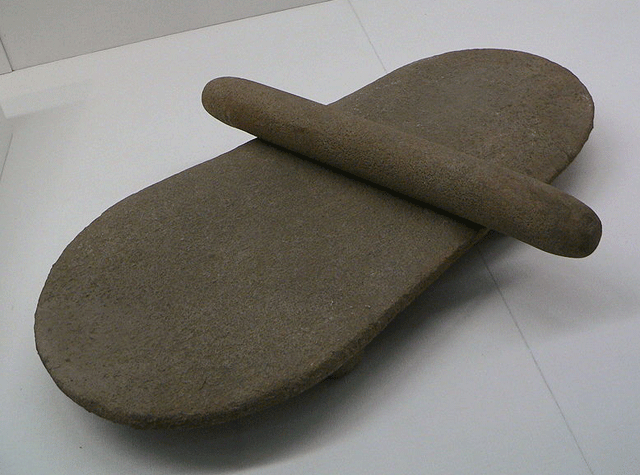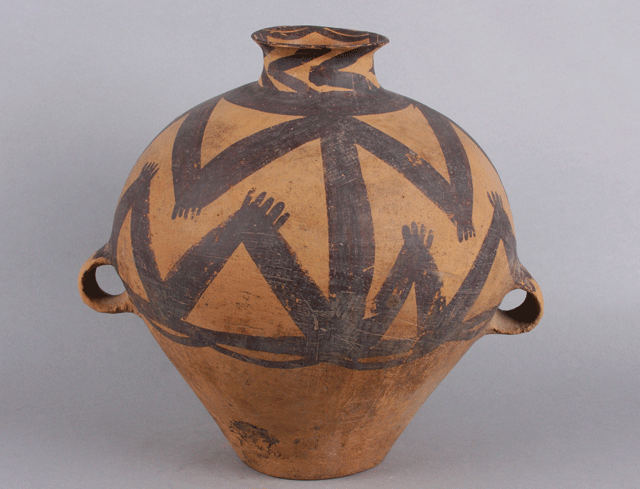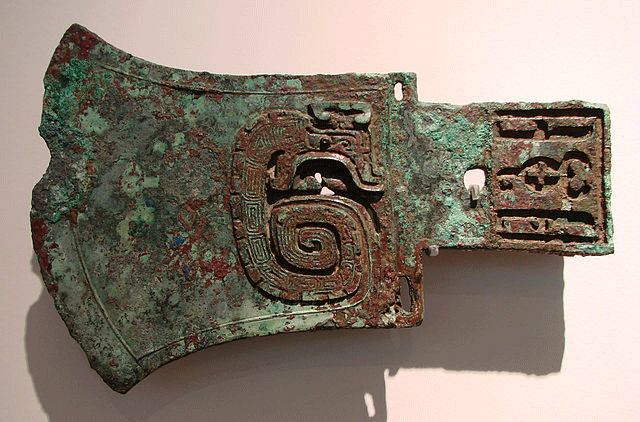
Neolithic food grinding stones from Peiligang, Xinzheng,
at the Zehgzhou Museum, China

Neolithic food grinding stones from Peiligang, Xinzheng,
at the Zehgzhou Museum, China
If you count ancestral species such as Homo erectus, humans have lived in China for more than a million years. As happened elsewhere on the planet, after countless generations people eventually began cultivating selected species in order to supplement their wild foods. In China, this shift began about 12,000 years ago. Based on genetic evidence, rice was domesticated in the Pearl River region of China. Another early grain was millet. Once fully domesticated foods are present, archaeologists refer to cultures as being part of the Neolithic period. The Neolithic life way was widely established in China by about 9,000 years ago. By about 7,000 years ago, people started settling down in villages.
The photo at the start of this page shows Neolithic period stone tools used
to process grain.
Grain was placed on the large lower stone (or "quern") and was ground
by moving the upper stone back and forth in one's hands. Similar tools
have been used around the world from the Neolithic period until today.

2012.91.8, Neolithic painted jar, low-fired pottery
Eason Eige Collection; photo by B. Bernard.
The Chinese developed pottery while still hunters and gatherers, but once settled farming life began the use of pottery proliferated. Compared to pieces from later periods, early Chinese pottery can look rather crude or simple. There are two reasons for this. First, it took many centuries to develop new ceramic technologies, such as the use of the wheel. Second, no one was in a rush to create more sophisticated pottery. For villagers, the low-fired pots they made did the job quite well. If anything, attempts to outdo each other's pottery (and other crafts) would have seemed antisocial, given the egalitarian nature of early farming communities.
Around the world, what happened next depended how well farming succeeded. Where farming allowed populations to keep growing, human society increasingly divided into rulers and ruled. The change happened so slowly that people may not have noticed—but it did happen. By China's Bronze Age (about 2,000 to 600 BCE) it was possible to find societies divided into kings, nobles, and commoners.
In the final 2000 years before the founding of a unified empire, three
kingdoms stand out in Chinese accounts: the Xia, Shang, and Zhou. The Xia
dynasty (2200 to 1600 BCE) remains lost in the shadows of legend,
but the existence of the Shang dynasty (1600 to 1122 BCE) has been confirmed
by archaeology. The Shang kingdom lay along the eastern Yellow River. Most
of its people were farmers, who were ruled by a warrior aristocracy. Shang
"oracle bones," used primarily for divination, contain the earliest known
Chinese writing. The Shang are also known for their bronze artifacts, including
elaborate vessels and weapons. In 1122 BCE the Zhou, vassals of the Shang,
seized and established a dynasty that lasted until 255 BCE.

Shang dynasty decorated axe at the Musée Guimet, Paris
The competitiion between China's various kingdoms culminated in the Warring States period, which lasted from 480 to 221 BCE. One kingdom, Qin, finally conquered all of its rivals and its king became the first emperor of China.
See source code for copyright information.
Page last revised on December 10, 2014.
Please report problems to dap@unm.edu